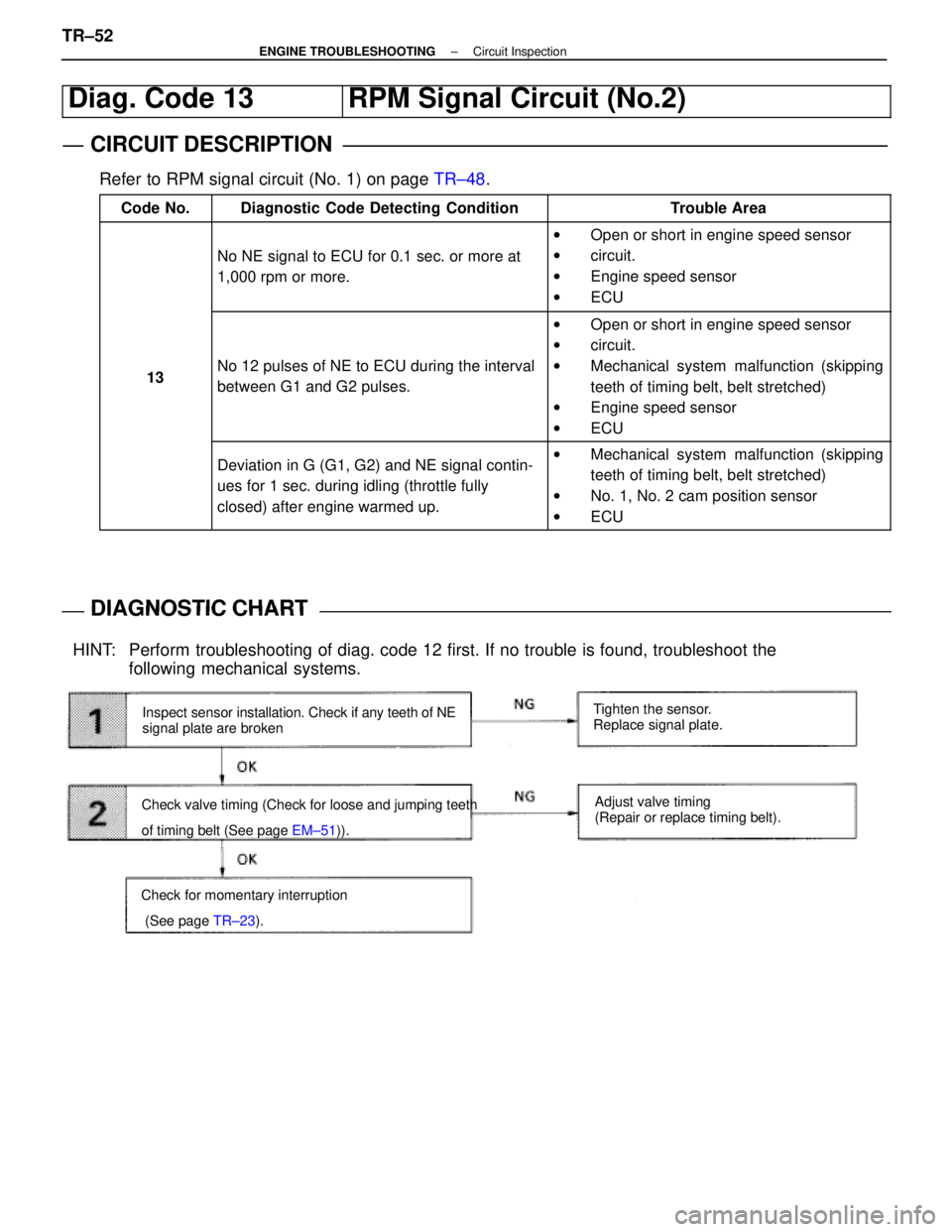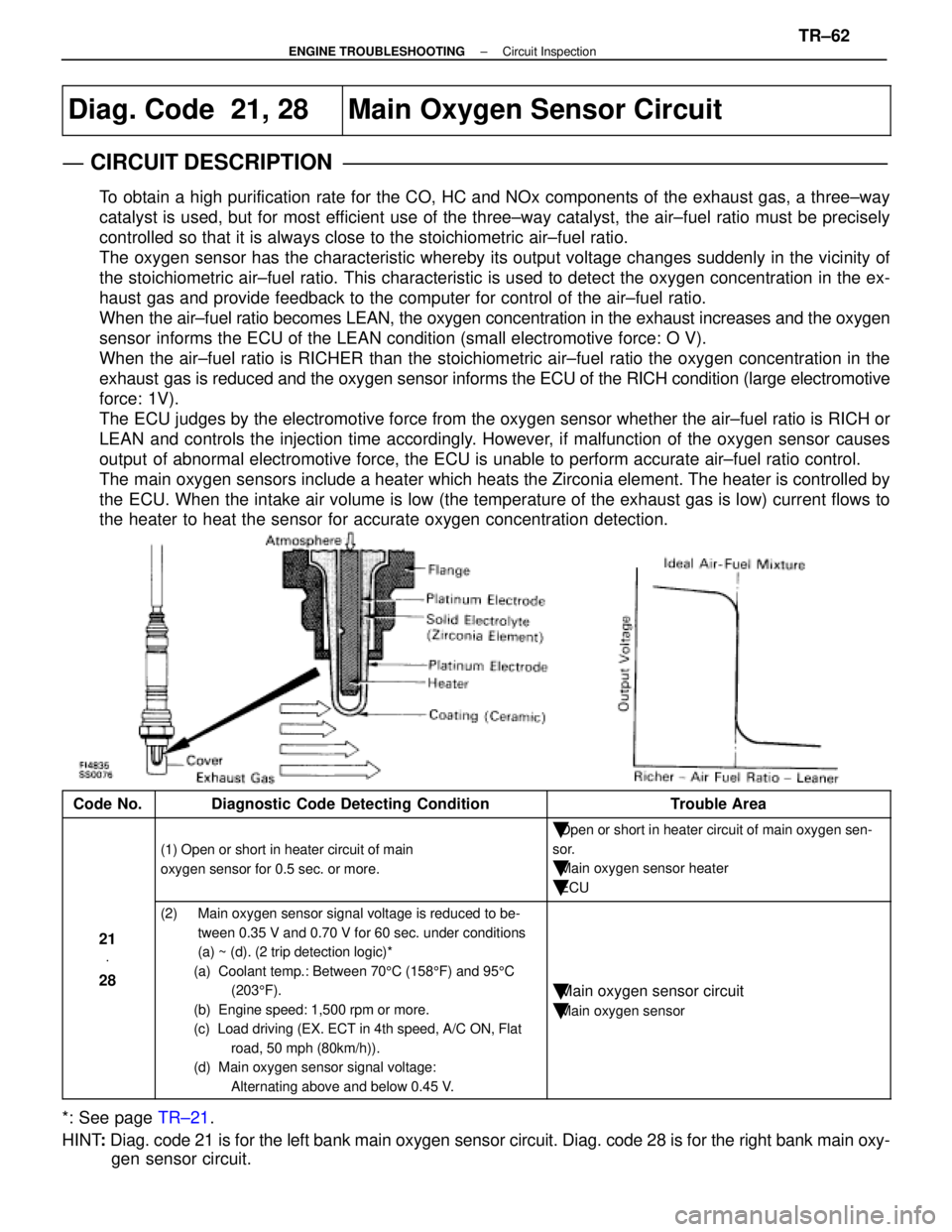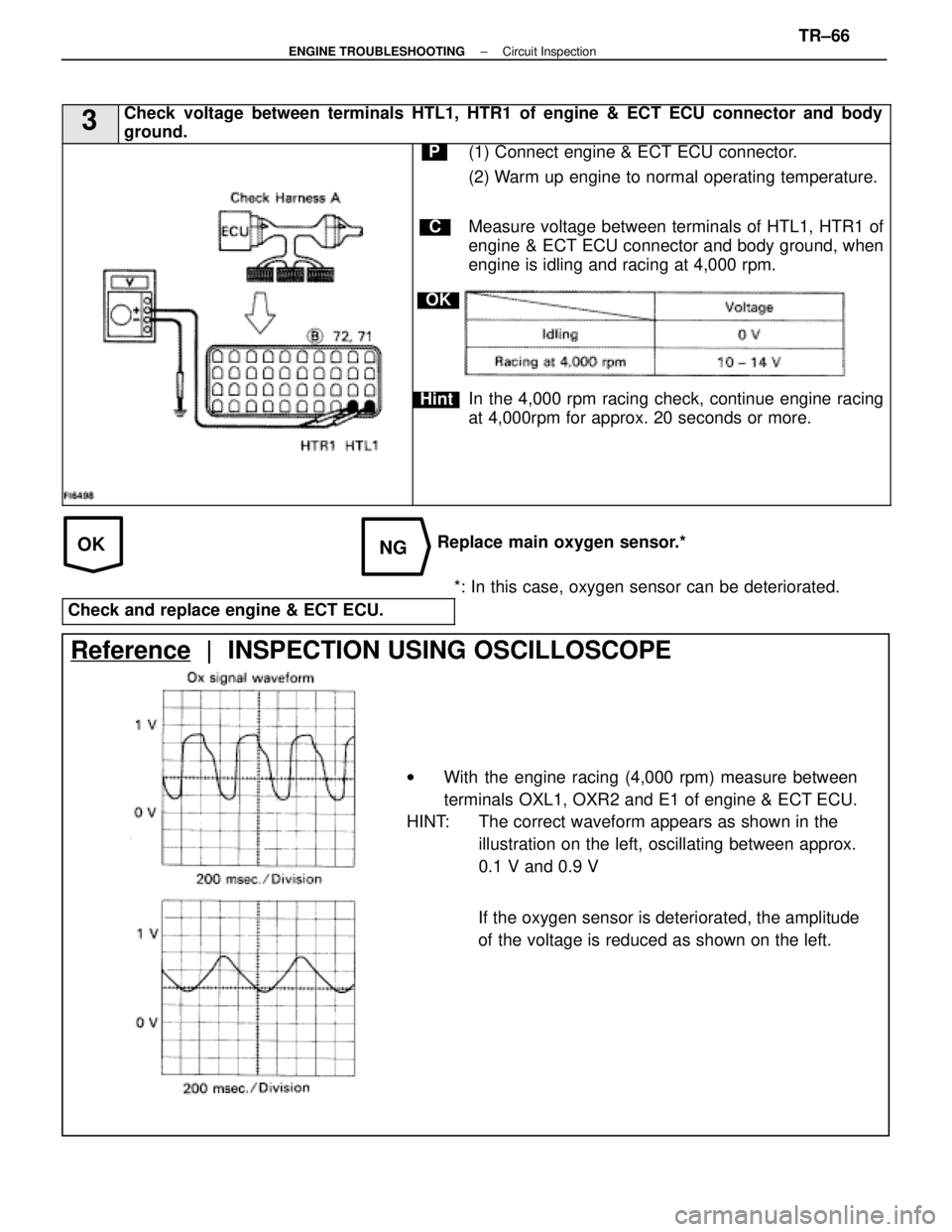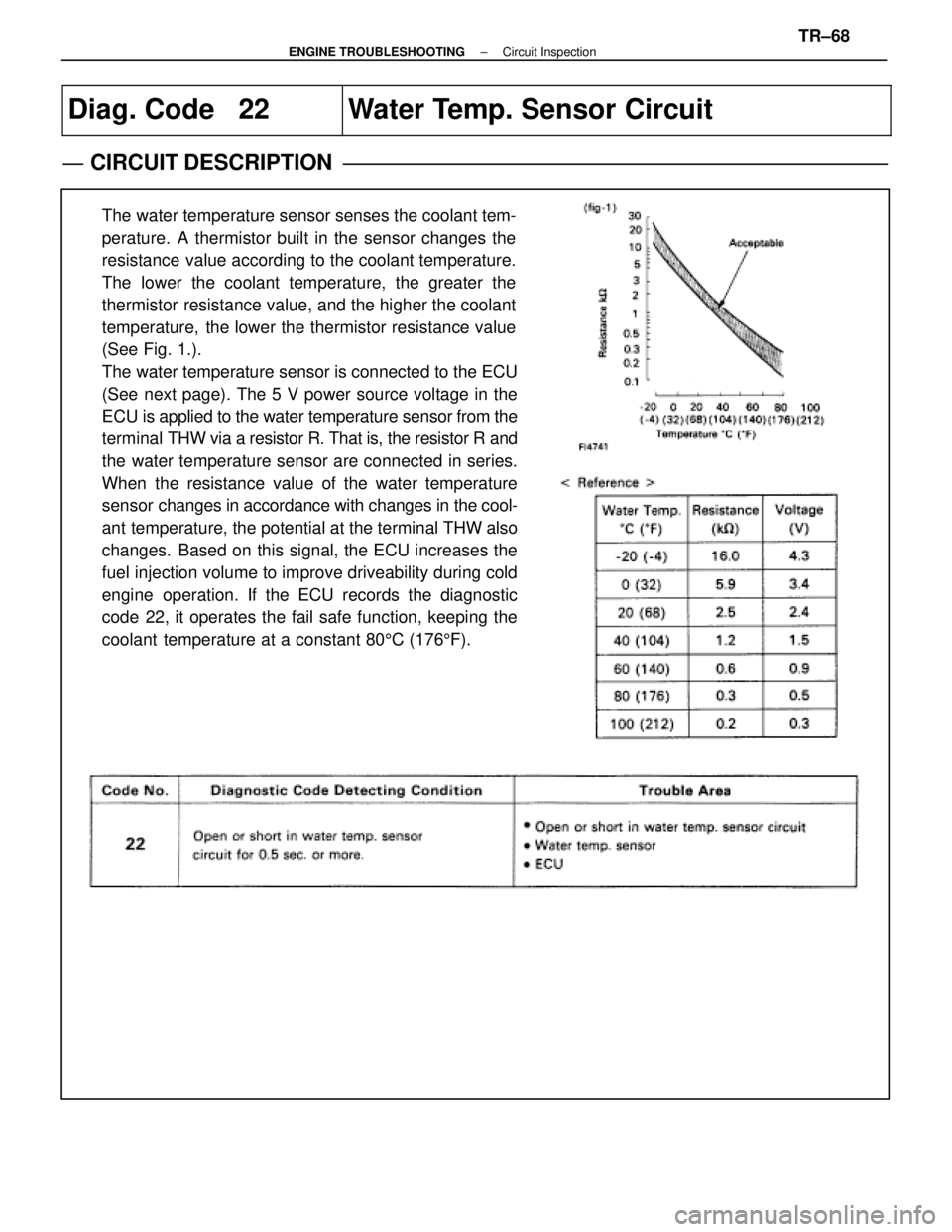Page 2661 of 4087
OKNG
INSPECTION PROCEDURE
1Check engine speed sensor, No. 1, No. 2 cam position sensor
C
OK
PFor engine speed sensor.
(2) Remove engine under cover.
(2) Disconnected engine speed sensor connector.
For No.1, No. 2 cam position sensor,
(2) Disconnect No. 1, No. 2 cam poisition sensor con-nectors.
Measure resistance of engine speed sencor, No. 1 and
No. 2 cam position sensor.
Replace engine speed sensor, No. 1, No. 2 cam poistion
sensor.
TR±50
±
ENGINE TROUBLESHOOTING Circuit Inspection
WhereEverybodyKnowsYourName
Page 2662 of 4087
OKNG
OKNG
2Check for open and short in harness and connector between engine & ECT ECU an\
d each sen-
sor (See page IN±27).
Repair or replace harness or connector.
3Inspect sensor installation and teeth of signal plate.
Tighen the sensor.
Replace signal plate.
Check and replace engine and ECT ECU.
±
ENGINE TROUBLESHOOTING Circuit InspectionTR±51
WhereEverybodyKnowsYourName
Page 2663 of 4087

Diag. Code 13RPM Signal Circuit (No.2)
CIRCUIT DESCRIPTION
Refer to RPM signal circuit (No. 1) on page TR±48.
Code No.Diagnostic Code Detecting ConditionTrouble Area
No NE signal to ECU for 0.1 sec. or more at
1,000 rpm or more.
wOpen or short in engine speed sensor
w circuit.
w Engine speed sensor
w ECU
13No 12 pulses of NE to ECU during the interval
between G1 and G2 pulses.
wOpen or short in engine speed sensor
w circuit.
w Mechanical system malfunction (skipping
teeth of timing belt, belt stretched)
w Engine speed sensor
w ECU
Deviation in G (G1, G2) and NE signal contin-
ues for 1 sec. during idling (throttle fully
closed) after engine warmed up.wMechanical system malfunction (skipping
teeth of timing belt, belt stretched)
w No. 1, No. 2 cam position sensor
w ECU
DIAGNOSTIC CHARTDIAGNOSTIC CHART
Inspect sensor installation. Check if any teeth of NE
signal plate are broken
Check valve timing (Check for loose and jumping teeth
of timing belt (See page EM±51)). Tighten the sensor.
Replace signal plate.
Adjust valve timing
(Repair or replace timing belt).
HINT: Perform troubleshooting of diag. code 12 first. If no trouble is found, trouble\
shoot the following mechanical systems.
Check for momentary interruption
(See page TR±23).
TR±52±
ENGINE TROUBLESHOOTING Circuit Inspection
WhereEverybodyKnowsYourName
Page 2673 of 4087

Diag. Code 21, 28Main Oxygen Sensor Circuit
CIRCUIT DESCRIPTION
To obtain a high purification rate for the CO, HC and NOx components of th\
e exhaust gas, a three±way
catalyst is used, but for most efficient use of the three±way catalyst, the air±fuel ratio must be \
precisely
controlled so that it is always close to the stoichiometric air±fuel \
ratio.
The oxygen sensor has the characteristic whereby its output voltage chan\
ges suddenly in the vicinity of
the stoichiometric air±fuel ratio. This characteristic is used to det\
ect the oxygen concentration in the ex-
haust gas and provide feedback to the computer for control of the air±\
fuel ratio.
When the air±fuel ratio becomes LEAN, the oxygen concentration in the exh\
aust increases and the oxygen
sensor informs the ECU of the LEAN condition (small electromotive force: O V)\
.
When the air±fuel ratio is RICHER than the stoichiometric air±fuel\
ratio the oxygen concentration in the
exhaust gas is reduced and the oxygen sensor informs the ECU of the RICH condition (large electromotive
force: 1V).
The ECU judges by the electromotive force from the oxygen sensor whether th\
e air±fuel ratio is RICH or
LEAN and controls the injection time accordingly. However, if malfunction of the oxygen sensor causes
output of abnormal electromotive force, the ECU is unable to perform accurate \
air±fuel ratio control.
The main oxygen sensors include a heater which heats the Zirconia element. The heater is controlled by
the ECU. When the intake air volume is low (the temperature of the exhaust\
gas is low) current flows to
the heater to heat the sensor for accurate oxygen concentration detectio\
n.
Code No.Diagnostic Code Detecting ConditionTrouble Area
(1) Open or short in heater circuit of main
oxygen sensor for 0.5 sec. or more.
�Open or short in heater circuit of main oxygen sen-
sor.
�Main oxygen sensor heater
�ECU
21 V
28
(2) Main oxygen sensor signal voltage is reduced to be-
tween 0.35 V and 0.70 V for 60 sec. under conditions
(a) ~ (d). (2 trip detection logic)*
(a) Coolant temp.: Between 70 5C (158 5F) and 95 5C
(203 5F).
(b) Engine speed: 1,500 rpm or more.
(c) Load driving (EX. ECT in 4th speed, A/C ON, Flat road, 50 mph (80km/h)).
(d) Main oxygen sensor signal voltage:
Alternating above and below 0.45 V.
�Main oxygen sensor circuit
�Main oxygen sensor
*: See page TR±21.
HINT : Diag. code 21 is for the left bank main oxygen sensor circuit. Diag. co\
de 28 is for the right bank main oxy-
gen sensor circuit.
±
ENGINE TROUBLESHOOTING Circuit InspectionTR±62
WhereEverybodyKnowsYourName
Page 2675 of 4087
DIAGNOSTIC CHART
DIAGNOSTIC
CHART
WIRING DIAGRAM
HINT: If diag. code º21º is output, check the left bank main oxygen sens\
or circuit. If diag. code º28º is output, check the right bank main oxygen sensor circuit.
Check voltage of terminals HTL1, HTR1.
Check resistance of oxygen sensor heater.
Check and repair oxygen sensor heater circuit.
Check operation of oxygen sensor heater.
Check and replace ECU. Replace main oxygen sensor.
*: In this case, oxygen sensor can be deteriorated.
Replace main oxygen sensor.*
±
ENGINE TROUBLESHOOTING Circuit InspectionTR±64
WhereEverybodyKnowsYourName
Page 2676 of 4087
OKNG
OKNG
INSPECTION PROCEDURE
1Disconnect the engine & ECT ECU connector, check voltage between terminals HTL1, HTR1 of
engine & ECT ECU connector and body ground.
C
OK
P(2) Connect the Check Harness A.(See page TR±30)
(2) Disconnect engine & ECT ECU connector.
(2) Turn ignition switch on.
Measure voltage beween terminals HTL1, HTR1 of en-
gine & ECT ECU connector and body ground.
Voltage: 10 ± 14 V
Go to step [3].
2Check main oxygen sensor heater.
C
OK
PDisconnect main oxygen sensor connector.
Measure resistance between terminals 1 and 2 of main
oxygen sensor connector.
Resistance: 5.1 ± 6.3 � at 20 �C (68 �F)
Replace main oxygen sensor.
Check and repair harness or connector between
main relay and main oxygen sensor, main oxygen
sensor and engine & ECT ECU.
TR±65±
ENGINE TROUBLESHOOTING Circuit Inspection
WhereEverybodyKnowsYourName
Page 2677 of 4087

OKNG
3Check voltage between terminals HTL1, HTR1 of engine & ECT ECU connector and \
body
ground.
C
OK
Hint
P(1) Connect engine & ECT ECU connector.
(2) Warm up engine to normal operating temperature.
Measure voltage between terminals of HTL1, HTR1 of
engine & ECT ECU connector and body ground, when
engine is idling and racing at 4,000 rpm.
In the 4,000 rpm racing check, continue engine racing
at 4,000rpm for approx. 20 seconds or more.
Replace main oxygen sensor.**: In this case, oxygen sensor can be deteriorated.
Check and replace engine & ECT ECU.
Reference | INSPECTION USING OSCILLOSCOPE
w With the engine racing (4,000 rpm) measure between
terminals OXL1, OXR2 and E1 of engine & ECT ECU.
HINT: The correct waveform appears as shown in the
illustration on the left, oscillating between approx.
0.1 V and 0.9 V
If the oxygen sensor is deteriorated, the amplitude
of the voltage is reduced as shown on the left.
±
ENGINE TROUBLESHOOTING Circuit InspectionTR±66
WhereEverybodyKnowsYourName
Page 2679 of 4087

Diag. Code 22Water Temp. Sensor Circuit
CIRCUIT DESCRIPTION
The water temperature sensor senses the coolant tem-
perature. A thermistor built in the sensor changes the
resistance value according to the coolant temperature.
The lower the coolant temperature, the greater the
thermistor resistance value, and the higher the coolant
temperature, the lower the thermistor resistance value
(See Fig. 1.).
The water temperature sensor is connected to the ECU
(See next page). The 5 V power source voltage in the
ECU is applied to the water temperature sensor from the
terminal THW via a resistor R. That is, the resistor R and
the water temperature sensor are connected in series.
When the resistance value of the water temperature
sensor changes in accordance with changes in the cool-
ant temperature, the potential at the terminal THW also
changes. Based on this signal, the ECU increases the
fuel injection volume to improve driveability during cold
engine operation. If the ECU records the diagnostic
code 22, it operates the fail safe function, keeping the
coolant temperature at a constant 80 5C (176 5F).
±
ENGINE TROUBLESHOOTING Circuit InspectionTR±68
WhereEverybodyKnowsYourName